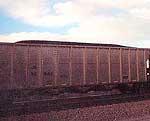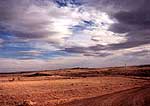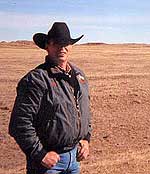By Aaron Alpern
Wyoming Public Radio
March 11, 2002
|
|
RealAudio |
The Dakota, Minnesota and Eastern railroad now has federal approval to lay 280 miles of new track into Wyoming's Powder River Basin. Most of the attention has focused on the railroad's plans to haul coal. But DM&E also hauls farm commodities, and that part of its business would also increase. As a result, the rail project has created a split between two groups that usually agree - farmers and ranchers.
| |
|
|
|
||
Grain silos are fixtures in the small towns along the DM&E's line through Minnesota and South Dakota. Farmers depend on the railroad as a cheap way to get their products to market. While much of the talk about this rail expansion focuses on coal, many of the rail cars will still carry wheat, sunflower seeds, soybeans and other cash crops. In many ways, the future of farmers on the Great Plains will be dictated by the railroad and its expansion dreams.
The DM&E's new line would open up several areas to the region's farmers. They could access processing centers in eastern Iowa and western Illinois, and markets in the Pacific Northwest. Jim Palmer represents Minnesota's soybean growers. He says for farmers, current shipping options are a little like a house with a bad floor plan.
"We're a house with a front door, meaning the Mississippi River, and a small back window, meaning the West Coast. We could turn that West Coast into a full back door for us to ship our beans out. We'd have two ways to export those beans. It would be very beneficial to us," says Palmer.
New markets aren't the only benefit. The expansion would also make the DM&E a much more efficient railroad. The result - not just a larger potential market, but a faster way to reach those customers. Mike Held, administrative director of the South Dakota Farm Bureau, says a South Dakota State University study shows just how much farmers will benefit.
"It indicated that net farm income will increase about $90 million every year because of those two factors. So we think that's one of the main reasons why it's in the best interests of agriculture," says Held.
| |
|
|
|
||
And net farm income should go up even further. Farmers will access more new markets because of the DM&E's recent acquisition of a 1,700-mile railroad connecting Kansas City, Chicago, and the Twin Cities. So this expansion is a move that will mean cheaper transportation costs for farmers and potentially more money in their pockets.
But it's an all-or-nothing proposition. DM&E officials say they can't stay in business without the project. And with no railroad, farmers would be forced to ship by truck, which is much more expensive. Jim Palmer from the Minnesota Soybean Growers Association says farmers are relying on the project to stay afloat.
"The DM&E expansion is a couple of steps forward. Loss of the DM&E would probably be about 20 steps backward," says Palmer.
But support for the DM&E project is far from unanimous. The new track will bisect the properties of about 85 rural landowners.
Weston County, Wyo., is home to many ranches along the DM&E's route. It is rugged, wide-open country with miles of treeless prairie. These ranches are well outside of Newcastle, the nearest town. It's roughly a 30-mile drive down a dusty, gravel road before you come to Mike Harris' cattle ranch. The DM&E expansion will lay tracks across Harris' property, and cut off more than one-third of his ranch from the rest of his land. Harris says it will be a major disruption.
| |
|
|
|
||
"I'm going to have to change about 10 to 15 miles of fence. I'd have to change around maybe four to eight miles of water pipelines. I'd have to change around tanks," says Harris. "I got some reservoirs that it'd be going over the top of that I'd have to replace. They'd be going over the top of a well or two. There's a well here that I depend on."
Harris isn't pleased with plans for underpasses along the new line. That's something a railroad does when they cut across private ranch land. Harris will use those underpasses to move his animals across the tracks. He says moving his cattle is costly.
"Anytime you start moving cattle, you take weight off your cows. Your cows is your market...that's what we get paid on is the weight on our cows. So then if every two, three miles there's a doggone underpass, I have to go two, three miles up one way to move my cattle, to come back two, three miles the other way," says Harris. "I would imagine that you're taking off $700, $800, $1,000 every time you move cattle. You do that every five, six, seven days - and over six months worth of time you take a lot of weight off them cows."
Harris and his neighbor Nancy Darnell are both members of the Mid-States Coalition for Progress. It's a group of about 150 landowners in South Dakota and Wyoming opposed to the DM&E expansion.
The proposed route will cut across the southern portion of Darnell's ranch. Her opposition to the project isn't just personal. From Darnell's perspective, the plan only serves to cut up more of the open spaces that Wyoming is famous for. And she worries ranchers can't afford to lose anything from their bottom line.
| |
|
|
|
||
"This area of Weston County are all viable businesses that are making it now...I'm guessing it would probably impact a lot of people at least $30,000 to $70,000 a year. And you take that much away from them, and you've taken out their living," she says.
Darnell also says ranchers will lose some of the supplemental income they receive from hunting. She says the expansion will cause irreparable damage to deer, antelope, and grouse habitat. It's likely the noise of trains rolling by 30 or more times a day will make hunters look elsewhere for quieter hunting grounds.
But not every rancher is set against the railroad. Some, like Bob Stoddard, are using a different approach. Stoddard shares many of the same concerns as those fighting the plan. But he's learned form experience that fighting only hurts more in the end.
Stoddard's land was crossed in the 1970s, when Burlington Northern built its first line into the Powder River Basin coalfields. He fought that project, and says his compensation from the company suffered because of it. That's why Stoddard is working with the DM&E this time around, even though his operation will be hurt by their expansion.
"I'm sure that if they continue on with their project and they get their permits, that us guys who worked with them will be paid better," says Stoddard. "But with the past experience I had with the other railroads, you can fight them until hell freezes over. But when they get their permits, here they come. And you better be prepared."
Still, Stoddard says he would be pleased and relieved if his neighbors were able to win their fight against the railroad. The Mid-States Coalition for Progress has filed a lawsuit to stop the project in the 8th Circuit Court of Appeals in Missouri. That case is scheduled to start next month.
More from MPR



